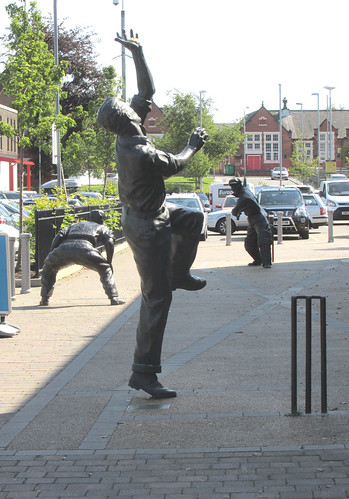 |
| Larwood bowls to Bradman |
The tactic was seen as aggressive and threatening, and certainly 'not cricket, old man'. No-one was injured during the run up to the 1932 test series, but the Aussies saw the whole event as offensive, and feelings were running high. In the opening Test in Sydney England bowler Harold Larwood took 10 wickets using Bodyline.
Aussie captain Bill Woodfull refused to retaliate, saying he would never use tactics that would bring the game discredit. Australia won the second Test, much to the delight of the home nation. But in the third Test in Adelaide Woodfull was hit in the chest by a ball from Larwood, and spent many minutes doubled over in pain. The crowd was incensed and a riot narrowly avoided. The next day a ball from Larwood, delivered conventionally, struck wicket keeper Bert Oldfield on the head, fracturing his skull.
 |
| Bradman at the wicket |
The row rumbled on, however, and in 1935 the MCC (cricket's ruling body) brought in new laws that meant captains had to play in the 'spirit of the game' and made it clear that Bodyline breached that spirit.
Indirectly, the 1932 debacle led to an increase in protective clothing worn by batsmen and wicket keepers. Threatening and body-close bowling is used in the modern game, but the consequences are less severe because of the armour.
So what made me choose this topic? Well, for reasons I won't go into, I had to be in Kirkby in Ashfield in Nottinghamshire this week, birthplace of Bodyline bowler Harold Larwood. The event is commemorated (if that's the right word) by a sculpture outside the town library. A full length wicket (22 yards) with life-size figures in bronze.
For some reason Larwood emigrated to Australia in the 1950s where he was welcomed and even asked to commentate on matches between the two countries. He died, aged 90, in 1995
The sculpture was created by Neale Andrew and erected in 2002.
Anyone who knows anything about cricket will have realised by now that I don't know much. Apologies to those who understand it - and care about it.

Any time we pass a park and people are playing cricket we have to stop and watch, it looks so elegant. Haven't a clue about the rules or how it's played.
ReplyDeleteI know about the 'bodyline scandal', but not the detail and was certainly unaware of this wonderful sculpture. Surely, I must find a reason to visit Kirkby in Ashfield - there must be one... I enjoy watching cricket, but confess to being sadly ignorant of the rules. I think I was scarred by missing an easy catch and being out for a duck (the latter not my fault) when I was 11.
ReplyDeleteTo be fair, there's not much else to visit in Kirkby in Ashfield - though it's not a long way from Eastwood, where D H Lawrence lived (if you like that sort of thing).
DeleteWhat a brilliant piece of sculpture! I wonder whether my husband has seen it, I must ask him. He's in Derby watching cricket today. Being married to a cricket afficionado I'm familiar with the Bodyline fracas of course.
ReplyDeleteGrew up in a cricket mad household although I never liked it very much. My step father's family were cricketers his elder brother played for Derbyshire, England and was an umpire and test selector and their uncle also played for Derbyshire and England. Charlie and Hary Eliott their names. My stepfather played for a local team and I and Mum went every Saturday afternoon in the summer to help make the teas. Have heard many a conversation about bodyline but didn't know of the statue, it looks an interesting one:)
ReplyDeleteCricket is not very well known in Belgium, there are a few clubs but not at all like in England.
ReplyDelete